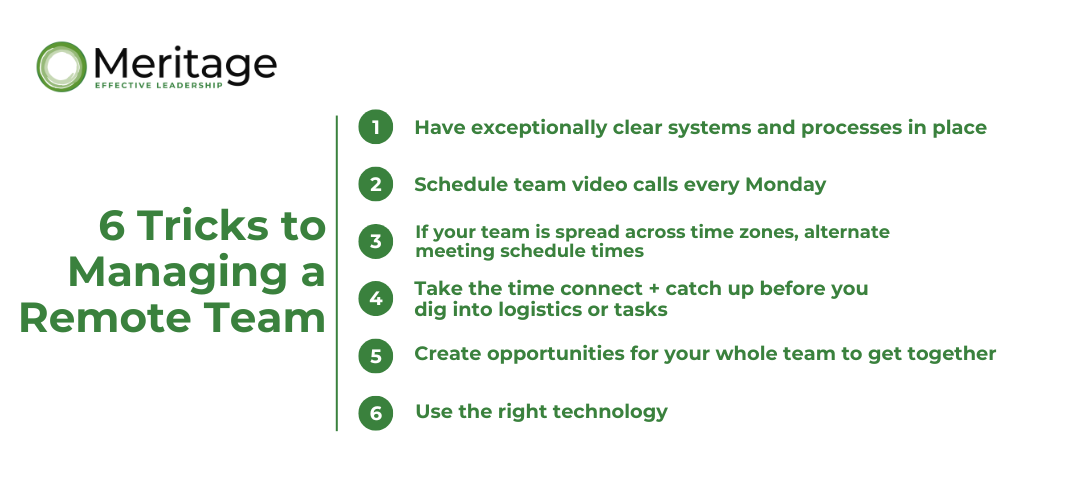“I have no idea how to keep my remote team connected and motivated consistently. Zero,” my client sighs over her coffee.
We’re sitting in the corner booth of a cozy coffee shop in San Francisco on a rainy Tuesday, catching up on her business, her team, and life in general.
“My product manger is in Dubai, so we’re always asking him to take conference calls late at night. Some people hate Slack, some people love it. The email chains are 15 emails long and by the time I get to the end I forgot what the original question was. Maybe I should just go back to an in-person, only-in-this-zip-code team.” She rolls her eyes and groans.
I’ve had this conversation more times than I can count. Years ago, I’m sure I was saying these things myself! These conversations are becoming more common because over the past 12 years, we’ve seen a 115% increase in people working remotely. In 2018, 3.9 million Americans were working remotely.

It’s likely that number will only increase. Remote work can lead to more efficiency and productivity, boosts morale, and lowers overhead. On the other hand, it’s harder to manage communication and keep people aligned on priorities when the whole team is working remotely.
If you’d like to bring on more remote workers or are struggling with the ones you have, read on for six of my best learned-the-hard-way tips for managing a remote team.
Curious how remote leadership differs from in-office management? Explore our Leadership EDGE course to build communication, clarity, and influence across virtual teams.
6 Tricks to Managing a Remote Team
1. Have exceptionally clear systems and processes in place
Of course, effective systems are always important, but they’re even more important when your team is spread all over the world. Make sure everyone on your team knows what steps to take, with whom, and when. To build an internal knowledge management system, you may want to consider using AskSpoke.
It’s equally important that your team knows where to find that information—and hopefully it’s not you! The best-run teams rely on each other before they escalate to their leader. Or they reference available video training, resource documents, or their onboarding training before they come to someone with questions. A good tool for process documentation to check out is process.st.
As leaders, we don’t want to be the center cog in the system that keeps everything running. We want to lead a team that can function and excel on its own, without constantly flooding us with basic questions or manageable concerns.
2. Schedule team video calls every Monday
Seeing each other’s faces and hearing each other’s voices is a great way to start the week. It’s a good reminder that there are actual humans on the other end of those emails. When we communicate exclusively through email, a lot of tone gets lost and miscommunications are more common.
A weekly check-in video call reduces those miscommunications, increases understanding, and reminds us that Chris in marketing has a sarcastic sense of humor and we don’t need to take those emails too seriously. It seems simple, but I often see leaders using video too infrequently. Getting on a regular schedule where everyone connects creates consistency in communication.
Weekly team touchpoints are powerful—but only if your leaders know how to lead with presence. Learn how in our Leadership EDGE coaching cohort.
3. If your team is spread across time zones, alternate meeting schedule times
If your team is split between New York and L.A., your west coasters don’t appreciate the 9 am EST meetings. Likewise, your New Yorkers could do without the calls at 5 pm PST on Friday night. It’s even harder if you have team members all over the world!
It’s not always possible to schedule meetings at the perfect time for everyone, but we can at least alternate. Make sure that your meetings aren’t scheduled at a time that consistently inconveniences the same team members.
4. Take the time connect + catch up before you dig into logistics or tasks
As tempting as it is to skip the small talk, it’s more important than ever to spend the extra five or ten minutes to chat with your remote team members before you get down to the proverbial brass tacks. Taking the time to talk about your vacations or your shared affinity for that one TV show can make a huge difference in morale.
When we work with our team members in person, these conversations happen naturally. We talk about our weekends in the lunchroom or share a joke at the vending machine. It’s harder to build that camaraderie over email chains.
The truth is, we’re more likely to help and support colleagues we like, and we’re more inclined to like a colleague when we know they love James Corden as much as we do. So take a few extra minutes at the beginning of your calls to chat and build your relationships. Your company’s retention rate will thank you!
5. Create opportunities for your whole team to get together
There’s no hard and fast rule for how often remote teams “should” meet in person. It depends on you, your team, and everyone’s needs and personalities. But pretty much any remote team will benefit from getting together at least once or twice a year. So make the effort to make it happen.
This could look like quarterly, half-day meet-ups if you live in the same state or a two-day retreat someplace special. Team members could all attend the same yearly conference to learn new things and catch up in person. Two birds, one stone!
Regardless of how it looks or how often it happens, find a way for your team to spend time together in ‘real life.’ It will improve communication, deepen relationships, and make operations run more smoothly.
6. Use the right technology
The right software can make team connectivity a breeze, no matter how many time zones it’s spread across. Here at Meritage, we love the project management platform Redbooth. Remember from tip #2 how important clear systems are? Redbooth is where my team knowledge shares their process templates, how-to steps, task status, and FAQs to fix issues—all online—and without involving me. Of course, we love Google Apps for sharing documents and editing them together in real time. Loom makes it easy for us to do quick screen share tutorials with each other or send video responses, which are sometimes more time effective than a string of emails or trying to find time for a phone call. Dropbox is perfect for sharing and organizing big files.
Is there a learning curve to managing a remote team? Of course. But the benefits of hiring remote workers—lower overhead, higher morale, better productivity and efficiency—dramatically outweigh any challenges.

We help leaders build greater connectivity, trust and efficiency in their teams (remote and local). Help is just an email away. . .


